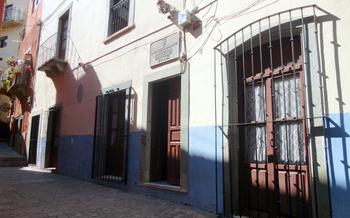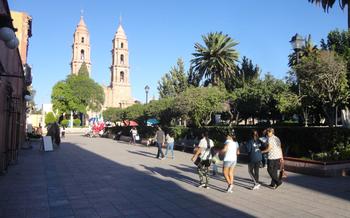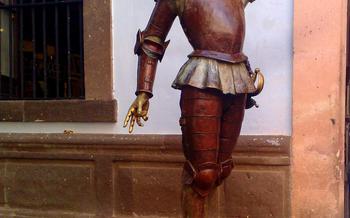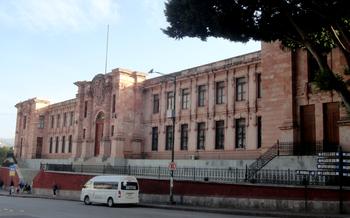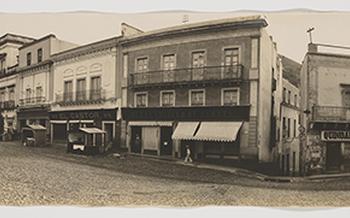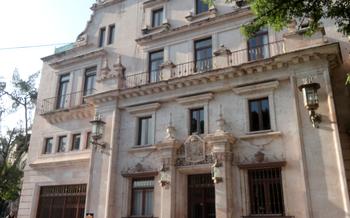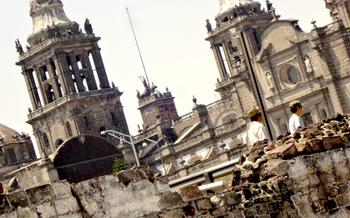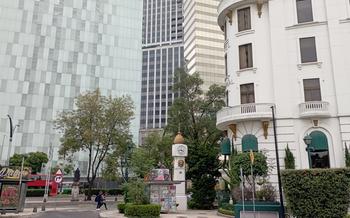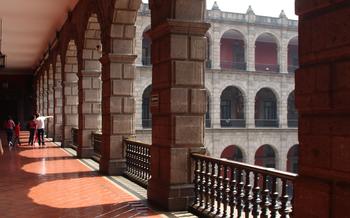Iconographic Museum of Don Quixote (Museo Iconográfico del Quijote)
- A Literary Landmark
- A Journey Through Cervantes' Masterpiece
- Interactive Exhibitions and Displays
- Thematic Galleries and Collections
- Literary and Cultural Significance
- Educational Programs and Workshops
- Temporary Exhibitions and Special Events
- Research and Documentation Center
- Guided Tours and Accessibility
- Museum Store and Souvenirs
- Location and Transportation
- Photography and Social Media
A Literary Landmark
The Museo Iconográfico del Quijote stands as a testament to the enduring legacy of Miguel de Cervantes' masterpiece, "Don Quixote." Located in the heart of Guanajuato, Mexico, this museum is a treasure trove of art and artifacts inspired by the iconic novel. Through its diverse collection, interactive exhibitions, and educational programs, the museum invites visitors to delve into the rich literary and cultural heritage of "Don Quixote" and its universal appeal.
A testament to the novel's profound impact, the museum boasts a collection of over 1,500 pieces, including paintings, sculptures, engravings, and tapestries. These artworks, created by renowned artists from around the world, capture the essence of Cervantes' characters and the timeless themes of his novel. Visitors can trace the evolution of Don Quixote's image through the centuries, from his humble beginnings as Alonso Quijano to his transformation into the "Knight of the Sad Countenance."
The museum's establishment is a story of passion and dedication. Founded in 1987 by a group of Cervantes enthusiasts, the museum initially occupied a small space within the University of Guanajuato. As its collection grew, the museum moved to its current location in 1994, a beautifully restored 18th-century building that once served as a Jesuit college.
One of the most intriguing anecdotes surrounding the museum's founding is the discovery of a rare edition of "Don Quixote" during its early days. While cataloging the collection, a museum curator stumbled upon a first edition of the novel, published in Madrid in 160This precious volume, one of only a handful known to exist, became a cornerstone of the museum's collection and a symbol of its commitment to preserving Cervantes' legacy.
A Journey Through Cervantes' Masterpiece
The Museo Iconográfico del Quijote houses an impressive collection of over 1,500 pieces of art and artifacts inspired by the literary masterpiece "Don Quixote" by Miguel de Cervantes. These artworks encompass a wide range of mediums, including paintings, sculptures, engravings, tapestries, and ceramics. Visitors can trace the evolution of Don Quixote's character and his adventures through the diverse artistic representations on display.
Among the highlights of the collection are the paintings by Salvador Dalí, which offer a surreal and dreamlike interpretation of the novel's scenes. The museum also features an extensive collection of sculptures, including a bronze statue of Don Quixote and Sancho Panza by Josep Clarà, which captures the essence of their complex relationship.
The artworks in the museum not only showcase the enduring legacy of "Don Quixote" but also provide a glimpse into the creative processes and inspirations of the artists who were drawn to the novel's themes and characters. Visitors can gain a deeper appreciation for Cervantes' masterpiece by exploring the diverse artistic interpretations of his work at the Museo Iconográfico del Quijote.
Interactive Exhibitions and Displays
The Museo Iconográfico del Quijote engages visitors through a variety of interactive exhibitions and multimedia displays that bring the world of Don Quixote to life. Audio-visual presentations, touchscreens, and hands-on exhibits allow visitors to explore different aspects of the novel and its cultural impact in a dynamic and engaging way.
One of the highlights of the museum is the interactive timeline that traces the evolution of Don Quixote's story from its initial publication in 1605 to its enduring legacy in popular culture. Visitors can navigate through the timeline, selecting different periods to learn about the novel's influence on literature, art, music, and film.
Another popular exhibit is the "Quijote in the World" display, which showcases adaptations and translations of the novel in over 100 languages. Visitors can use touchscreens to browse through different editions and learn about the challenges and triumphs of translating Cervantes' masterpiece into various cultural contexts.
The museum also features a dedicated space for children, where they can engage in interactive activities and games related to Don Quixote and his adventures. Through storytelling, puzzles, and creative workshops, children can explore the themes of the novel and develop their own interpretations of the iconic characters.
These interactive exhibitions and displays not only enhance the museum experience but also make the world of Don Quixote accessible to visitors of all ages and backgrounds, fostering a deeper appreciation for Cervantes' literary genius and the enduring legacy of his masterpiece.
Thematic Galleries and Collections
The Museo Iconográfico del Quijote is divided into several thematic galleries and collections, each showcasing a specific aspect of "Don Quixote." The "Gallery of Illustrations" features a vast collection of drawings, engravings, and prints that depict scenes from the novel, offering a visual interpretation of Cervantes' masterpiece. In the "Gallery of Sculptures," visitors can admire three-dimensional representations of Don Quixote and Sancho Panza, capturing their iconic poses and expressions. The "Gallery of Tapestries" displays a series of intricate tapestries woven with scenes from the novel, providing a unique perspective on the story's characters and themes.
Other notable galleries include the "Gallery of Ceramics," which showcases ceramic pieces inspired by "Don Quixote"; the "Gallery of Comics," which presents comic book adaptations of the novel; and the "Gallery of Children's Books," which features illustrated versions of the story designed for young readers. Each gallery provides a unique lens through which to explore the enduring legacy and diverse interpretations of Cervantes' beloved work.
Literary and Cultural Significance
The Museo Iconográfico del Quijote stands as a testament to the profound impact of Miguel de Cervantes' masterpiece, "Don Quixote," on the literary and cultural heritage of Mexico and Spain. The museum serves as a repository of the novel's enduring legacy, preserving and showcasing the diverse artistic interpretations and cultural expressions inspired by this timeless work.
By highlighting the various artistic representations of Don Quixote and Sancho Panza, the museum underscores the novel's universal appeal and its ability to transcend cultural boundaries. The diverse collection of artworks, ranging from paintings and sculptures to engravings and tapestries, reflects the enduring fascination with Cervantes' characters and their iconic adventures.
Moreover, the museum plays a vital role in fostering cultural exchange and dialogue between Mexico and other countries. Through its exhibitions and educational programs, the museum promotes a deeper understanding of Cervantes' work and its influence on global literature and popular culture. The museum's dedication to preserving and celebrating the legacy of "Don Quixote" contributes to a vibrant cultural landscape that transcends national borders, uniting people from all walks of life in their appreciation for this literary masterpiece.
Educational Programs and Workshops
The Museo Iconográfico del Quijote is dedicated to promoting the study and appreciation of "Don Quixote" through various educational programs and workshops. In collaboration with educational institutions and cultural organizations, the museum offers a range of educational experiences for students, researchers, and the general public.
One notable program is the "Cervantes and His Work" workshop, which delves into the life and works of Miguel de Cervantes, focusing on the historical and cultural context of "Don Quixote." Participants engage in discussions, analysis, and creative activities inspired by the novel.
The museum also organizes creative writing workshops, where aspiring writers can explore the themes and characters of "Don Quixote" through their own writing. These workshops provide a platform for participants to express their creativity and gain insights into the art of storytelling.
For students and researchers, the museum offers specialized workshops on topics such as literary analysis, art history, and the cultural impact of "Don Quixote." These workshops are led by experts in the field and provide participants with an opportunity to engage in in-depth study and research.
The educational programs and workshops at the Museo Iconográfico del Quijote aim to foster a deeper understanding and appreciation of Cervantes' masterpiece, while inspiring creativity and encouraging cultural exchange.
Temporary Exhibitions and Special Events
The Museo Iconográfico del Quijote also hosts a dynamic calendar of temporary exhibitions and special events throughout the year, offering visitors an ever-changing array of experiences. These exhibitions showcase a diverse range of topics related to "Don Quixote," from retrospectives of renowned artists to thematic displays exploring specific aspects of the novel. The museum also organizes special events such as lectures, book signings, and cultural performances, creating a vibrant and engaging space for visitors to delve deeper into the world of Cervantes' masterpiece.
One memorable event was a retrospective exhibition dedicated to the works of renowned Mexican artist José Clemente Orozco. The exhibition showcased a collection of Orozco's powerful murals and paintings inspired by "Don Quixote," offering visitors a unique perspective on the novel's themes and characters through the lens of a master artist.
Another highlight was a special event featuring a live performance of excerpts from "Don Quixote" by a local theater company. The performance brought the characters and stories of the novel to life, captivating the audience with their vibrant energy and dramatic flair.
These temporary exhibitions and special events add an extra layer of excitement and variety to the museum's offerings, ensuring that there is always something new and engaging to discover for visitors of all ages and interests.
Research and Documentation Center
The Museo Iconográfico del Quijote houses a comprehensive research and documentation center dedicated to the study of Miguel de Cervantes' masterpiece, "Don Quixote." This invaluable resource is a haven for scholars, researchers, and enthusiasts seeking to delve deeper into the novel's literary, historical, and cultural significance.
The center boasts an extensive library specializing in Cervantes and his works, with a vast collection of books, manuscripts, and critical studies. Researchers can access a treasure trove of primary sources, including early editions of "Don Quixote," translations in various languages, and scholarly journals. The center also houses a rich archive of documents, such as correspondence, contracts, and personal artifacts related to Cervantes and his contemporaries.
The documentation center facilitates academic research and collaboration by providing access to state-of-the-art research facilities, including computers, scanners, and microfilm readers. Researchers can explore digital databases, consult with experts in the field, and participate in conferences, seminars, and workshops organized by the museum. The center's resources and expertise have contributed to numerous publications, dissertations, and academic projects, fostering a vibrant community of scholars dedicated to preserving and promoting the legacy of Cervantes and his work.
Guided Tours and Accessibility
The Museo Iconográfico del Quijote offers guided tours in various languages, including English, Spanish, and French, to provide visitors with a deeper understanding of the museum's collection and the significance of Cervantes' masterpiece. Knowledgeable and passionate guides lead these tours, sharing insights into the artistic representations of Don Quixote and Sancho Panza, the creative processes behind the artworks, and the enduring legacy of the novel. Visitors can also request customized tours tailored to their interests or specific themes within the museum's collection.
For visitors with disabilities, the museum is committed to providing a welcoming and accessible environment. Wheelchair ramps and elevators ensure that all levels of the museum are accessible, and audio guides are available for the visually impaired. Visitors with hearing impairments can request sign language interpretation in advance to enhance their museum experience. The museum's staff is always ready to assist visitors with any special needs or requests to ensure an enjoyable and inclusive visit.
Museum Store and Souvenirs
The Museo Iconográfico del Quijote houses a charming museum store where visitors can find a treasure trove of souvenirs, books, and merchandise inspired by the beloved novel and its iconic characters. From intricately designed replicas of Don Quixote's helmet to whimsical Sancho Panza figurines, the store offers a wide range of unique and memorable items. Visitors can also purchase beautifully illustrated editions of "Don Quixote" in various languages, as well as scholarly books and essays exploring the novel's literary and cultural significance. The revenue generated from the museum store plays a crucial role in supporting the museum's sustainability and educational programs, ensuring its continued dedication to preserving and promoting the legacy of Cervantes' masterpiece.
Location and Transportation
The Museo Iconográfico del Quijote is conveniently located in the heart of Guanajuato's historic center, a UNESCO World Heritage Site. It is situated on the Plaza de la Muerte, just a short walk from the city's main square, the Jardín de la Unión. Visitors can easily reach the museum on foot or by taking a short taxi ride from any point in the city.
For those arriving by public transportation, the museum is accessible via the city's efficient bus system. Several bus lines stop within walking distance of the museum, making it easy for visitors to connect from various parts of the city.
To ensure a smooth and enjoyable visit, it is advisable to plan your trip in advance. The museum's website provides detailed directions and a map to assist visitors in navigating to the museum easily. Additionally, the museum's staff is always ready to provide guidance and assistance to ensure a memorable experience for all visitors.
Photography and Social Media
The Museo Iconográfico del Quijote encourages visitors to share their experiences and photos on social media. Visitors are allowed to take photos and videos inside the museum, except for in certain areas where photography is restricted. The museum also has a dedicated hashtag, #MuseoQuijote, which visitors can use to share their photos and connect with other museum-goers.
In addition, the museum regularly organizes creative and engaging social media campaigns and initiatives. Visitors can participate in these campaigns by sharing their photos, videos, or stories related to the museum and "Don Quixote." The museum also uses social media to promote its exhibitions, events, and educational programs.
By sharing their experiences on social media, visitors can help to promote the museum and its mission to preserve and celebrate the legacy of "Don Quixote." Visitors can also use social media to connect with other fans of the novel and share their insights and perspectives on Cervantes' masterpiece.
